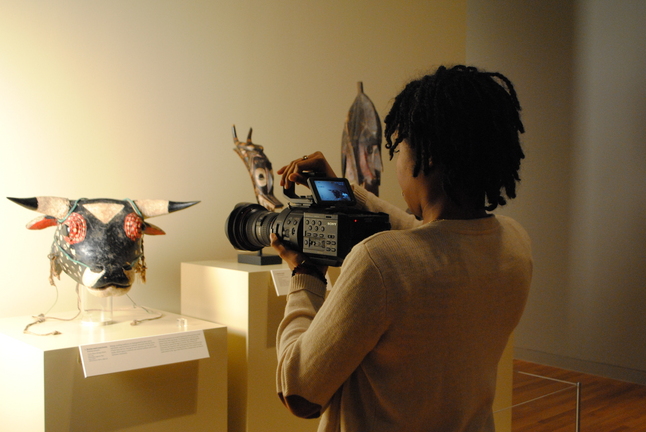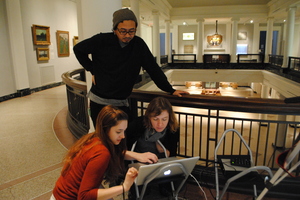UMMA's Many Voices project provides possibility for deeper connection in a '17 second world'

Ashlee Arder films for her Many Voices video.
Courtesy of the University of Michigan Museum of Art
The Many Voices project allows art enthusiasts to connect to the museum’s newly installed Wi-Fi network and access a variety of resources including videos produced by the museum, links to related websites, audio files and photos.
Visitors can walk through UMMA’s galleries and scan QR codes or type in a numeric code (located on artwork labels) on the Many Voices mobile website to access related materials. Resources can also be accessed from home, but content is limited due to copyright.
Manager of Public Programs and Campus Engagement for UMMA Lisa Herbert Borgsdorf said Many Voices, introduced in May, was the museum's next step in creating an interactive environment for visitors after the installment of the dialog table about eight years ago.
“UMMA’s dialog table allows people to interact with the collection in a totally different way because it isn’t set up by geography or time and gives them access to extra resources like videos,” Borgsdorf said. “At the time we did the dialog table, we didn’t have Wi-Fi fully installed in all of the galleries, but this spring we were able to do so and that opened up a lot of possibilities for us.”
After receiving grant funding from the National Endowment for the Arts and the Community Foundation of Southeast Michigan, the museum was able to create a platform that would allow the community access to more resources and the museum’s gallery in a digital format.
In addition to the interactive platform, grant funding allowed the museum to develop videos with the help of community members to add to resources available to the public.
“Many Voices allowed us to invite a number of people - we picked 17 - to make movies in response to the art in our collection,” Deputy Director of Education and Curatorial at UMMA Ruth Slavin said. “We wanted a mix of novice and experienced filmmakers who had an artistic practice of some kind, whether it was art, music or writing.”
Donald Harrison, an independent filmmaker and former executive director of the Ann Arbor Film Festival, and independent filmmaker Sharad Patel were hired to instruct several workshops and aid in video production.
“We sat down with 30 or 40 applicants and selected 13 from that pool,” Slavin said. “We were looking for a balance in the class between novice and experienced participants, between artist and non-artist and people with a variety of ages and backgrounds. Then we picked people we thought were interesting, committed and sounded like they had a good reason for doing it.”
Harrison and Patel as well as two mentors who were recruited to provide extra support for novice filmmakers also made videos.

From left to right: Collin McRae, Sudandyo Aprilianto and Emilia Javanica work on Aprilianto's film, "Rodance".
Courtesy of the University of Michigan Museum of Art
“We held our first workshop meeting in early November,” Slavin said. “The workshops lasted for about three months and then went in to the later production stage. We started by meeting each other and learning about the museum to learning about the project, picking a work of art to center the video around, creating a story board and then starting to shoot.”
By March, 17 videos created to provide viewers with a new perspective on the artwork were added to the museum’s many resources.
“The movies were a way of engaging a few selected community members in an exciting and deep way with the collection and then allowing them to share their experience with others,” Slavin said. “And the website was developed as a way to make those videos and other resources readily available; for us to work audio tours, movies, information, treasure hunts and games in to our galleries.”
The mobile website is meant to model rich conversations about the work and provide context about the pieces, Slavin said.
“When you come to an art museum, a lot of people just come to look and that is so important, but a lot of people come and they want a meaningful experience and they’re not exactly sure how to have it,” Slavin said. “That’s what the videos are for and what the mobile site is for. It’s to help people have that experience.”
Slavin said she hopes the videos will help visitors realize that someone spent five months with the artwork and that spending five months with one piece is possible.
“The average time someone looks at a piece of art is 17 seconds and that’s our society; that’s our world,” Slavin said. “It’s a 17 second world, but you can also have a different kind of experience.”
The Many Voices videos will be on view for another year, but Slavin said the videos will most likely remain available although they may not be featured.
It has not been determined if another round of Many Voices videos will be produced, Slavin said.
“You never know what is going to be the right next step for creating an engaging experience,” Borgsdorf said. “This particular model was very expensive and wouldn’t have been possible without the grant funding. Figuring out what is going to be the next way to engage our visitors and the community is our job. We don’t know if it’ll be another round of Many Voices videos or if it will be something completely different.”
Chelsea Hoedl is an intern reporter for AnnArbor.com. She can be reached at choedl@mlive.com.

